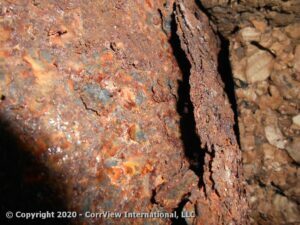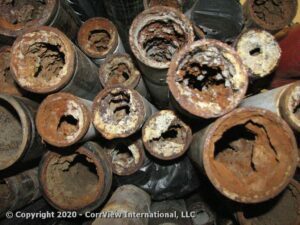Case History: CH-11
What’s Wrong With This Picture?
| Finding Any Excuse Upon Which To Discount Unwanted News |
-
Preface
A high rise commercial office building hires a new Chief Engineer. After a few weeks at the new property, he notices certain peculiarities at the condenser water system which prompts him to have CorrView conduct a full UT investigation. We are told there are no major issues, and that they are only interested in having a baseline assessment performed. The building is relatively new, having been constructed approximately 8 years prior. It has 24 in. condenser water risers at the top taking off to multiple package A/C units on each floor.
-
Investigation
Our testing identifies a higher than expected corrosion rate at about 2-3 time greater than normal. Greatest concerns exist at various by-pass configurations and futures where we suspect rust and other particulate debris have settled. We also find that even though lower floor pressures exceed 350 PSI, only schedule 40 pipe has been installed for any of its threaded lines. With a higher calculated minimum acceptable wall thickness as per Barlow, we find our measurements at most threaded fittings to have reached this minimum thickness limit, and some substantially below that limit.
Midway through our field investigation we are requested to report our findings to the Property Manager, who is conducting a monthly status update meeting with his staff. We begin explaining that a higher than normal corrosion rate exist when the property manager explodes at the news and immediately discounts our findings. We are warned to not report any such findings given that the property has the best chemical treatment program available, is maintained by the best technicians, and that they also have a private consultant overseeing chemical levels as well as monitoring their corrosion activity.
We are warned that our report will be scrutinized and that any such claims to a high corrosion rate best include some strong proof. Further ultrasonic testing the remainder of the day helps to confirm higher corrosion activity as well as identify even worse low wall thickness values at the threaded fittings.
A month or so later we receive a call from a water treatment consultant who has been provided our final report for review by the client. The consultant says its an unofficial courtesy call to inform us that he will be recommending to his client that they completely ignore and discount our report based upon two significant errors.
- The first is that we have mislabeled the East and West A/C package units on the 3rd floor opposite their true location. We have labeled East as West, and West as East. The consultant feels that this illustrates extreme carelessness on our part and that other errors likely exist, although no other errors have been identified.
- The second raised issue is that we have not provided the client with the highest wall thickness measurement found for each of the different test locations. The consultant feels this is most disingenuous, and that we are covering up the successes of the chemical treatment program where corrosion is well controlled.
We explain that both East and West A/C units are identical in equipment, design, and operation, and that any labeling to their location within the building is utterly irrelevant. Furthermore, we explain that our lowest and worst wall thickness measurements have been identified at at the 1 in. schedule 40 drain nipples at the very bottom of each 24 in. riser; a failure of which would be catastrophic. We also explain that when those pipe nipples fail, or when any other of the many examples of weakness presented in our report fail, the absolutely last question anyone from their senior management staff, to their insurance agent, to tenant retained attorney will be of the highest wall thickness value which existed prior to its failure.
As explained, we present the average of all 12 wall thickness measurements taken as well as the lowest individual measurement, and base our corrosion case estimates upon those two values under two separate corrosion scenarios. The highest wall thickness is actually presented in our Appendix in a spreadsheet of all thickness measurements for each location tested, although again, the highest thickness values is totally irrelevant. We also highlight the wall thickness spread or difference between high and low thickness values measured, which is another presentation of the same information they desire.
The consultant is not swayed, and recommends to his client to disregard the CorrView report.
We make corrections to the two report pages which have the East and West error and send them onto the chief engineer, who requests us to visit his office. Upon meeting, we find the request is not to further discuss the report or their consultant’s concerns, but to show us how wrong we have been in labeling East as West and West as East. Upon arriving at the 3rd floor East mechanical room, the chief engineer opens up his copy of our pipe testing report where a match-up of the A/C unit clearly shows our report having labeled it West. We agree to the mistake. Mea Culpa.
Before leaving the MER, a closer look at the bottom of the now reduced 8 in. supply riser shows a small stream of water originating from the bottom of the risers around the outside of the concrete slab to a floor drain. Further investigating, we find a sizable leak at the threads for the 1 in. nipple between riser and drain valve.
We stop the chief engineer from leaving, open our pipe testing report to the page representing our results at the bottom of the 8 in. supply riser, and point to the site location photo with the question, “What’s Wrong With This Picture?” The chief looks confused at the question until realizing that at the time the photograph was taken approximately 5-6 weeks prior, there was no leak and no water on the floor. Now, a constant high pressure stream of water indicates an imminent failure at a location that cannot be controlled. There is no shut-off valve and when this pipe nipple fails, the entire contents of cooling tower, 52 floors of large diameter risers under 365 lbs. of pressure, will be dumped on the floor directly above their spectacular new marble lobby.
The chief engineer goes into full panic mode and assigns further blame on CorrView by stating that we should have made him aware of this deficiency immediately. We return to the report submitted over a month ago and to our written assessment of pipe condition as capable of “imminent failure.” We actually described the pipe section as a “Paradox” given that based upon its extremely low wall thickness at only a few thousandths from the threads, and at the high pressure involved, it should have failed long ago. The warning could not have been made more clear.
-
Conclusion
The building brings in an HVAC contractor to freeze the 8 in. supply riser that night in order to replace the fitting, which breaks off at the threads when they attempt its removal. They repeat the same task a few weeks later to address the return riser which had also started to leak, as predicted. During some other nondestructive work at the same property,CorrView is chastised to the fact that the building had to spent close to $200,000 to repair the many other deficiencies documented in our report.
We subsequently learn that no chemical water treatment was provided to the building for the first 9 months of operation, under the guidance of the property manager.
© Copyright 2023 – William P. Duncan, CorrView International, LLC




















